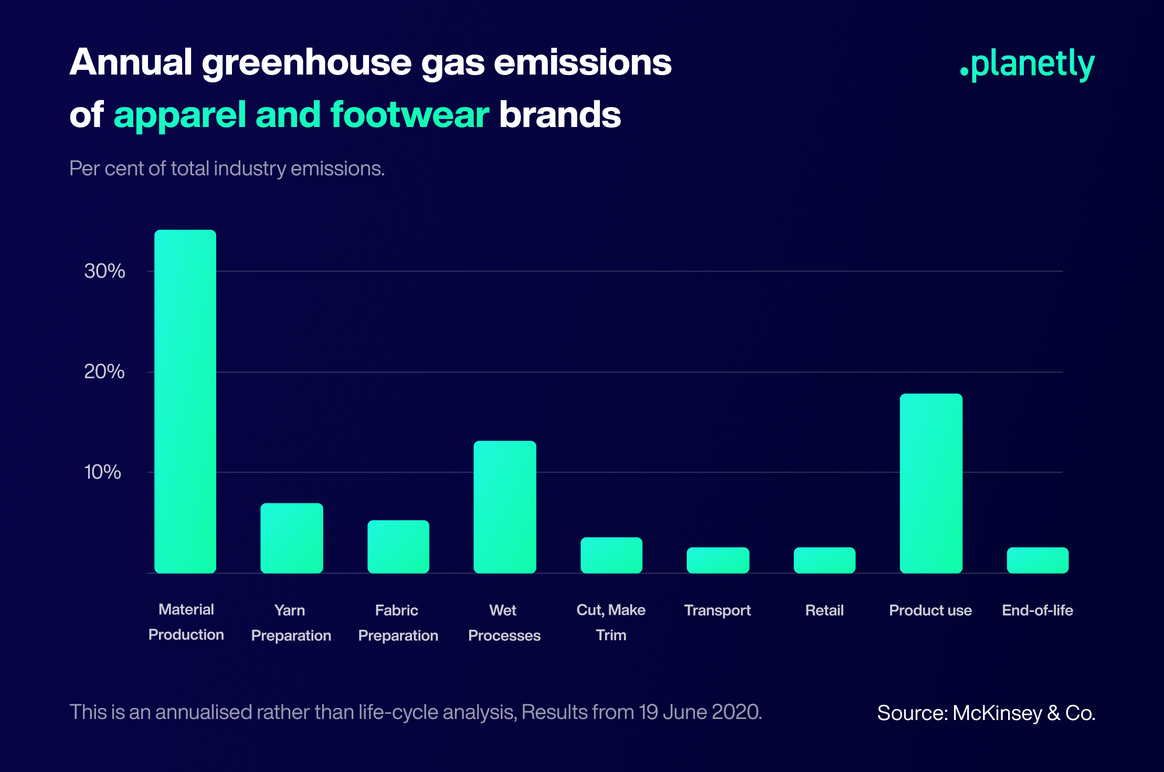
Fast fashion, pollution, carbon emissions, social issues: The fashion industry has a huge
impact on our planet on many different levels. According to McKinsey and the Fast Fashion
Agenda, the fashion industry was responsible for four percent of global carbon emissions in
2018. But where do these emissions come from?
71 percent of emissions come from upstream operations such as material production, wet
processes or yarn production. Around 23 percent stem from usage and proposal, including
product usage and end-of-use emissions. Inhouse operations like retail and transport
account for the last six percent of emissions.
More and more, fashion brands are held accountable for their environmental impact. For
example, the New York Fashion Act, currently pending in the New York State Senate, would
require fashion brands in New York with more than 100 million US-dollars in revenues to
map a minimum of 50 percent of the supply chain and to disclose material production
volumes. Brands need to present precise plans to reduce the biggest social and
environmental impacts.
There is no doubt that the future of fashion needs to be a sustainable one. Climate tech
company Planetly explains three ways how the fashion industry can move towards a
sustainable future:
1. Analyse Your Carbon Footprint
The first step is to measure the carbon footprint of your fashion business. This is important to
understand the magnitude of your environmental footprint and where your emissions are
coming from. According to the Greenhouse Gas Protocol, your emissions are divided into
three different categories:
● Scope 1: Direct Emissions
● Scope 2: Indirect emissions from the purchase of energy
● Scope 3: Indirect Emissions caused along the supply chain
Let’s take a look at an example: A German fair fashion label joined forces with Planetly to
calculate its carbon footprint including all emissions from core business activities (e.g.
buildings, employees), production of clothes as well as logistics: 85 percent of its emissions
are caused by the production of clothes. At the same time, 96 percent of emissions are
generated along the supply chain (scope 3).
Tools like Planetly’s Climate Impact Manager help businesses to calculate their company’s
carbon footprint in real-time. Planetly also supports brands in defining and implementing
effective measures to reduce emissions across the supply chain.
2. Take a Close Look at Your Supply Chain, Production
Processes and Materials
Emissions generated along the whole supply chain count towards your brand’s carbon
footprint as indirect emissions. As mentioned before, production of materials make up a
large part (38 percent according to McKinsey) of the overall apparel and footwear value
chain.
Here are some measures you can take to minimise the environmental impact of your brand:
● Work with your suppliers to help them reduce energy use and switch to regenerative
energy sources
● Focus on a local production of clothing to significantly lower transport emissions
● Source sustainable clothing materials like organic cotton, linen or tencel and use
them as efficiently as possible in your clothing design
3. Focus on a Circular Business Model
A largely circular fashion economy would minimise the impact of the fashion industry on the
environment. Let’s have a look at Patagonia: When designing the Tee-Cycle™ T-shirt,
Patagonia kept the whole product life cycle in mind. They are producing a zero-waste T-shirt
made from old t-shirts, while being in control of all the waste generated during the lifecycle of
the T-shirt.
On top of that, Patagonia puts an emphasis on second-hand and repairing clothing: Their
initiative Worn Wear has repaired more than 130,000 pieces of clothing since its launch in
2017 and they offer rentals for climbing and camping equipment.
The necessity to switch to more sustainable business models in the fashion industry is
imminent: Get in touch with us here at Plantely if you want to take the first steps towards
becoming a more sustainable fashion brand.



